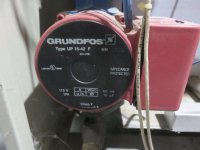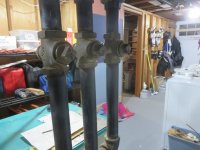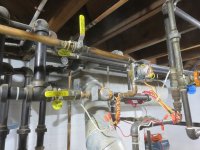Since there were no days that didn't have a heat load between 10/25/17 and 1/28/18 let's use the 387 therm total and the daily HDD65 from station
KMNSAINT20 in St. Paul (which is within your ZIP code.) To deal with the time of day the meter was read, sum the HDD from 10/25 through 1/27, and sum the HDD from 10/26 through 1/28, then average them.
10/25-1/27 HDD: 3772
10/26- 1/28 HDD: 3803
Average: 3788 HDD
Assuming the boiler's nameplate efficiency (DOE output divided by input) is 80%, the heat that went into the house was 0.8 x 387= 310 therms or 31 million BTU (MMBT).
So the BTU per HDD is (31,000,000/3788= ) 8184 BTU/day, or (/24=) 341 BTU per degree hour.
The
99% outside design temperature in Minneapolis is -11F, which is 76F colder than the presumptive 65F base, so you have an implied design heat load of:
76F x 341 BTU /F-hr= 25,916 BTU/hr
If using base 60F (appropriate if it's 2x6 /R19 with l0w-E windows) it would come in a bit more than that, but the load at -11F is still going to be under 30,000 BTU/hr (which makes the boiler ridiculously oversized for the heat load, but until and unless you're planning on replacing it we won't go there.)
As a sanity check, 26,000 BTU/hr for 1800' of fully above grade conditioned space is 14 BTU/hr per square foot, which would be possible for a VERY tight 2x4 framed 1800' house with decent low-E windows, or reasonably tight 2x6 /R19 house. If some amount of that 1800' is below grade the description of the insulation and air tightness could be quite a bit looser. (I have about 2400' fully above grade 2x4 framed house, 1600' of mostly below-grade insulated- conditioned but unfinished basement that would come in at 11 BTU/ft-hr @ -10F if I include the basement in the square footage numbers, 19 BTU/ft-hr for the whole-house load if I only include the above grade square footage.)
If you normally keep it 60F or colder while your away, and only 65F when your there pr something, tell me what your temperature setback schedule is and we'll pick a different temperature base. Using 65F as a base temp is appropriate if it's normally kept 68-72F when you're there, with maybe a setback to 65F at night or when you're at works/school.
So, we'll see how that works out in BTU per square foot EDR and figure out a reasonable starting point on operating temperatures.
Most cast iron boilers don't really have a minimum flow rate the way low-mass modulating boilers do. Many of them have a minimum temperature that's maintained by firing up even when there is zero flow and no load. As long as the in-to-out temperature difference (delta-T) isn't chronically more than 50F most will do fine, and if your flow is that low that it has delta-T for long periods of time (which can happen with under-fired boilers with high-thermal mass radiation) there is usually a bypass branch in the near-boiler plumbing to mix some of the boiler's output directly into the return water stream to keep the delta-T bounded.
With iron plumbing and an infra-red thermometer you can get quick temperature measurements accurate enough for this analysis. (A $30-$50 pistol-grip type IR thermometer from a box store is fine.) Copper, bronze or galvanized piping would give you a falsely low reading due to the low emissivity of the metal finish, but a daub of paint on the point where you're measuring would fix that. But black iron or rusty iron is perfect on it's own.
At the beginning of a call for heat the radiator water is tepid, and delta-T will be at it's highest, and is likely to be over 50F difference (90F back, 160F out or something). At the end of a call for heat it should be much lower. Measuring the individual delta-Ts on the radiator loops will tell you something too. Ideally with 150F+ entering water temp at the manifold you'd see a 20-25F delta-T on the return loop before it enters the manifold for most of the call for heat. If it's much more than 30F delta on all individual zones there may be a case for going with a bigger pump.
What I suspect is happening is that on the less-radiated loops you're getting a 10F delta, and on the one with the tepid rad it's more than a 50F delta. If you dial back the flows on the low-delta zones to bring them up to the 20-25F range, the high-delta zone should exhibit a much smaller delta than when you started.



